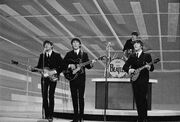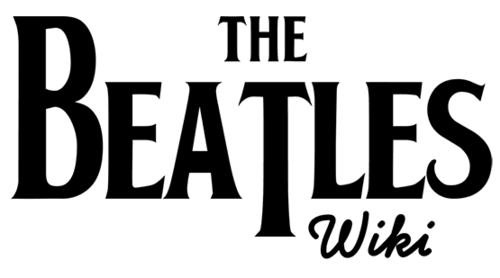
The Beatles made several appearances on The Ed Sullivan Show, including three in February 1964 that were among their first appearances in front of an American audience. Their first appearance, on February 9, was seen by over 73 million viewers and came to be regarded as a cultural watershed that launched American Beatlemania—as well as the wider British Invasion of American pop music—and inspired many young viewers to become rock musicians. The band also made another appearance during their 1965 U.S. tour.
Background[]
An American composer and champion of music Bernard Herrmann recalled in 1970 that around 1962 he had returned to the U.S. from a conducting job in Liverpool with early Parlophone records of the Beatles that he received from the band. According to him, the Beatles, at the time struggling to get noticed and recorded by major companies, were interested in an appearance on U.S. television programmes such as the Ed Sullivan Show and in making recordings with American record companies, in exchange for a pay of about a thousand dollars. Herrmann claimed to have unsuccessfully attempted to persuade the executives of Universal Records and Columbia Broadcasting System that the Beatles had something novel to offer.
The Beatles' fortunes changed after Ed Sullivan Show talent booker Jack Babb saw the band twice in concert in the UK the following year, after being invited by Peter Prichard, a London talent agent who was also a friend of Beatles manager Brian Epstein. Babb was initially uninterested in booking the group for the show, as British musical acts at that time experienced little commercial success in the U.S. Then, on October 31, Ed Sullivan was at London's Heathrow Airport and saw a crowd of 1,500 fans await the Beatles' return from a tour of Sweden. Struck by the crowds, Sullivan became interested in booking the Beatles for his show, and Prichard notified Epstein.
Epstein flew to New York on November 5 to promote another one of his acts, Billy J. Kramer and the Dakotas. Six days later, Epstein and Sullivan met at the Hotel Delmonico and agreed to have the Beatles perform three shows—two live and one taped. The Beatles ended up earning $2,400 ($17,396 in 2022 dollars) for the three shows.
The Beatles began to receive attention in the mainstream American press and radio play in November and December 1963. Due to rapidly growing listener demand, the band's first single on Capitol Records, "I Want to Hold Your Hand" was rush-released in late December, three weeks ahead of schedule. (Capitol had hoped that the single's original release date, on January 16, 1964, would allow the Beatles' Sullivan Show appearances in early February to bolster sales. Instead, the song reached the top of the Billboard Hot 100 chart on January 25, 1964, just before the Beatles were due to arrive in the U.S.)
Appearances[]
1964[]
The Beatles flew into John F. Kennedy International Airport on February 7 to a waiting crowd of 5,000 fans, and after a press conference arrived at the Plaza Hotel in Manhattan.
During the February 8 rehearsals for their first performance, lead guitarist George Harrison was confined to the hotel while recovering from strep throat; Beatles road manager Neil Aspinall and an Ed Sullivan Show staffer took turns standing in for George during the rehearsals.
February 9[]
CBS saw huge anticipation for the Beatles' first appearance, with 50,000 ticket requests for the 728-seat Studio 50 (now known as the Ed Sullivan Theater) where the band was to perform, far surpassing the 7,000 requested for Elvis Presley's 1957 debut. Among those in attendance were Richard Nixon's daughters, Julie and Tricia, who had been invited by NBC host Jack Paar's daughter, Randy. Backstage before the show, freshly minted Olympic gold-medal speed skater Terry McDermott, a part-time barber, posed for photographs with the band in which he pretended to cut Paul McCartney's hair as the other band members and Sullivan looked on with mock horror.
Sullivan began the show by telling the audience that Elvis Presley and his manager, Colonel Tom Parker, had sent the Beatles a telegram wishing them success in America (though it was reported later that Parker sent the telegram without Presley's knowledge). Sullivan then introduced the Beatles, who opened by performing "All My Loving"; "Till There Was You", which featured the names of the group members superimposed on closeup shots, including the famous "SORRY GIRLS, HE'S MARRIED" caption on John Lennon; and "She Loves You". The act that followed the Beatles in the broadcast, magician Fred Kaps, was pre-recorded in order to allow time for an elaborate set change. The group returned later in the program to perform "I Saw Her Standing There" and "I Want to Hold Your Hand".
The appearance on February 9 is considered a milestone in American pop culture, and furthermore the beginning of the British Invasion in music. The broadcast drew more than 73 million viewers, a record for U.S. television at the time (broken three years later by the series finale of The Fugitive). The broadcast drew a rating of 45.3 and a 60 share, and was Sullivan's first time in seven years that he topped the nightly ratings. (A typical Sullivan broadcast at the time drew about 21 million viewers.)
The Beatles had mixed reactions to the production value of their performance, with Paul McCartney later remarking that Lennon's microphone volume was too low.
February 16[]
After a February 11 concert in Washington, D.C.'s Washington Coliseum and two February 12 shows in New York's Carnegie Hall, the Beatles flew to Miami Beach on February 13, where Cassius Clay (later known as Muhammad Ali) was in training for his first title bout with Sonny Liston (on February 18, the Beatles would eventually pose for publicity photographs with Clay in a boxing gym). The Beatles held rehearsals on February 14 and 15. The band stayed in the Hotel Deauville, which was also the broadcast location for the show. The Beatles rehearsed in the hotel's basement.
On the evening of the television show, a crush of people nearly prevented the band from making it onstage. A wedge of policemen were needed and the band began playing "She Loves You" only seconds after reaching their instruments. They continued with "This Boy" and "All My Loving", then returned later to close the show with "I Saw Her Standing There", "From Me to You", and "I Want to Hold Your Hand".
The audience for this show was about 70 million, nearly equaling the prior week's performance.
February 23[]
The Beatles' third appearance aired on February 23, though it had actually been taped on February 9, before their first live performance. They followed Ed's intro with "Twist and Shout" and "Please Please Me" and closed the show once again with "I Want to Hold Your Hand".
May 24[]
On this occasion, the show aired an interview with the band and a taped performance of "You Can't Do That".
1965[]
The Beatles appeared live for the final time on August 14, 1965. The show was broadcast September 12, 1965, and earned Sullivan a 60-percent share of the nighttime audience for one of the appearances. This time they followed three acts before coming out to perform "I Feel Fine", "I'm Down", and "Act Naturally" and then closed the show with "Ticket to Ride", "Yesterday", and "Help!"
Later years[]
Although the Beatles rarely performed live after 1966, the group provided filmed promotional clips of songs to air exclusively on Sullivan's program over the next few years, including videos of both "Paperback Writer" and "Rain" from June 1966 and three clips from 1967, including "Penny Lane", "Strawberry Fields Forever", and "Hello, Goodbye".
The Beatles' last appearances on The Ed Sullivan Show came on March 1, 1970, when they released promotional videos for "Two of Us" and "Let It Be".
McCartney claimed in a 1990 press conference that he met Sullivan again in the early 1970s, though Sullivan appeared to have no memory of McCartney or the Beatles appearing on his show. Comedian Joan Rivers claimed subsequently that Sullivan was suffering from dementia by this time in his life. Sullivan died in 1974.
External links[]
| This article is a stub Please expand it if you can. |
